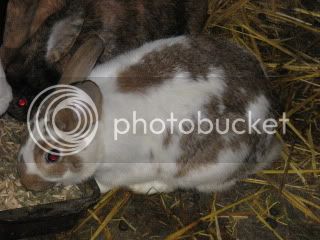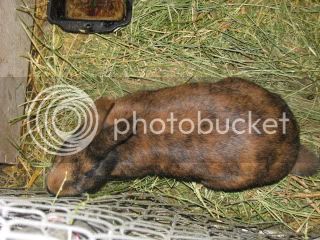pastelsummer":3nc73yp4 said:
if this
...
bred this
...
what would i get?
Better to ask "what
could I get" because there are no guarantees on how many of each parent's colour genes will be passed in what combination. Even if the odds say 50% of x colour, you might not get any! That's just the fun of genetics

Now... is the first rabbit a broken chestnut agouti? That's what it looks like to me, but I can't see the fur closely enough to tell. If so, chestnut agouti is A_B_C_D_E_. Since this rabbit has one of each dominant gene, we can't tell what their second gene is (remember, each colour gene is a pair: one from mom, one from dad).
The black japanese harlequin (assuming it is a pure harlequin and not a cross with something) would be A_B_C_D_ejej.
So you take one letter (or dash) from each parent and put them together. You get A_B_C_D_Eej which would be a chestnut who CARRIES harlequin or any other possible combo if the parents have recessives where the dashes are. You see how many possibilities there could be? It would take all morning to list them

IF the chestnut carries 'e' where the dash is then you could get You get A_B_C_D_eje which would be a harlequin type rabbit (perhaps poorly marked due to only one ej gene).
Now, add in the fact that the chestnut is broken. This is actually A_B_C_D_E_ with Enen. The broken gene is not one of the basic five, it's separate. To get a nicely patterned broken like the photo, the rabbit has one dominant (En-spotted) and one recessive (en-not spotted). The non-broken japanese has two enen (not spotted) genes. So your kits could be Enen (broken) or enen (not broken). If the Enen (broken) rabbits ALSO have harlequin gene (ej_) you get what is called a broken tri coloured rabbit - meaning spots of orange and black on a white background. If any harlequin kits are lucky enough to miss out on the dominant En from the chestnut parent, they will appear as harlequin patterned rabbits (although the pattern may be poor with only one 'ej').























































